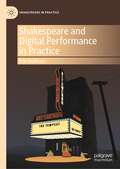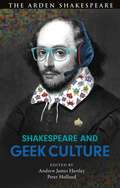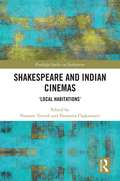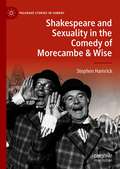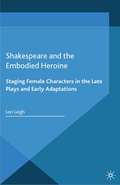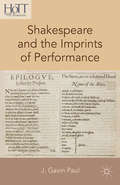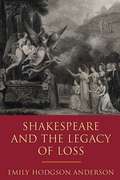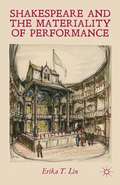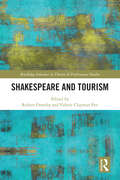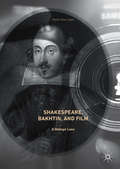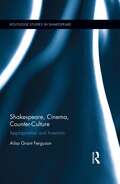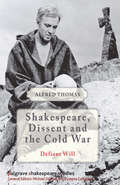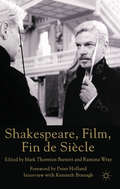- Table View
- List View
Shakespeare and Digital Performance in Practice (Shakespeare in Practice)
by Erin SullivanShakespeare and Digital Performance in Practice explores the impact of digital technologies on the theatrical performance of Shakespeare in the twenty-first century, both in terms of widening cultural access and developing new forms of artistry. Through close analysis of dozens of productions, both high-profile and lesser known, it examines the rise of live broadcasting and recording in the theatre, the growing use of live video feeds and dynamic projections on the mainstream stage, and experiments in born-digital theatre-making, including social media, virtual reality, and video-conferencing adaptations. In doing so, it argues that technologically adventurous performances of Shakespeare allow performers and audiences to test what they believe theatre to be, as well as to reflect on what it means to be present—with a work of art, with others, with oneself—in an increasingly online world.
Shakespeare and East Asia (Oxford Shakespeare Topics)
by Alexa Alice JoubinStructured around modes in which one might encounter Asian-themed performances and adaptations, Shakespeare and East Asia identifies four themes that distinguish post-1950s East Asian cinemas and theatres from works in other parts of the world: Japanese formalistic innovations in sound and spectacle; reparative adaptations from China, Taiwan, and Hong Kong; the politics of gender and reception of films and touring productions in South Korea and the UK; and multilingual, diaspora works in Singapore and the UK. These adaptations break new ground in sound and spectacle; they serve as a vehicle for artistic and political remediation or, in some cases, the critique of the myth of reparative interpretations of literature; they provide a forum where diasporic artists and audiences can grapple with contemporary issues; and, through international circulation, they are reshaping debates about the relationship between East Asia and Europe. Bringing film and theatre studies together, this book sheds new light on the two major genres in a comparative context and reveals deep structural and narratological connections among Asian and Anglophone performances. These adaptations are products of metacinematic and metatheatrical operations, contestations among genres for primacy, or experimentations with features of both film and theatre.
Shakespeare and East Asia (Oxford Shakespeare Topics)
by Alexa Alice JoubinStructured around modes in which one might encounter Asian-themed performances and adaptations, Shakespeare and East Asia identifies four themes that distinguish post-1950s East Asian cinemas and theatres from works in other parts of the world: Japanese formalistic innovations in sound and spectacle; reparative adaptations from China, Taiwan, and Hong Kong; the politics of gender and reception of films and touring productions in South Korea and the UK; and multilingual, diaspora works in Singapore and the UK. These adaptations break new ground in sound and spectacle; they serve as a vehicle for artistic and political remediation or, in some cases, the critique of the myth of reparative interpretations of literature; they provide a forum where diasporic artists and audiences can grapple with contemporary issues; and, through international circulation, they are reshaping debates about the relationship between East Asia and Europe. Bringing film and theatre studies together, this book sheds new light on the two major genres in a comparative context and reveals deep structural and narratological connections among Asian and Anglophone performances. These adaptations are products of metacinematic and metatheatrical operations, contestations among genres for primacy, or experimentations with features of both film and theatre.
Shakespeare and Geek Culture
by Andrew James Hartley and Peter HollandFrom fantasy and sci-fi to graphic novels, from boy scouts to board games, from blockbuster films to the cult of theatre, Shakespeare is everywhere in popular culture. Where there is popular culture there are fans and nerds and geeks. The essays in this collection on Shakespeare and Geek Culture take an innovative approach to the study of Shakespeare's cultural presences, situating his works, his image and his brand to locate and explore the nature of that geekiness that, the authors argue, is a vital but unrecognized feature of the world of those who enjoy and are obsessed by Shakespeare, whether they are scholars, film fans, theatre-goers or members of legions of other groupings in which Shakespeare plays his part.Working at the intersections of a wide range of fields ? including fan studies and film analysis, cultural studies and fantasy/sci-fi theory – the authors demonstrate how the particularities of the connection between Shakespeare and geek culture generate new insights into the plays, poems and their larger cultural legacy in the 21st century.
Shakespeare and Geek Culture
From fantasy and sci-fi to graphic novels, from boy scouts to board games, from blockbuster films to the cult of theatre, Shakespeare is everywhere in popular culture. Where there is popular culture there are fans and nerds and geeks. The essays in this collection on Shakespeare and Geek Culture take an innovative approach to the study of Shakespeare's cultural presences, situating his works, his image and his brand to locate and explore the nature of that geekiness that, the authors argue, is a vital but unrecognized feature of the world of those who enjoy and are obsessed by Shakespeare, whether they are scholars, film fans, theatre-goers or members of legions of other groupings in which Shakespeare plays his part.Working at the intersections of a wide range of fields ? including fan studies and film analysis, cultural studies and fantasy/sci-fi theory – the authors demonstrate how the particularities of the connection between Shakespeare and geek culture generate new insights into the plays, poems and their larger cultural legacy in the 21st century.
Shakespeare and Indian Cinemas: "Local Habitations" (Routledge Studies in Shakespeare)
by Poonam Trivedi Paromita ChakravartiThis book is the first to explore the rich archive of Shakespeare in Indian cinemas, including less familiar, Indian language cinemas to contribute to the assessment of the expanding repertoire of Shakespeare films worldwide. Essays cover mainstream and regional Indian cinemas such as the better known Tamil and Kannada, as well as the less familiar regions of the North Eastern states. The volume visits diverse filmic genres, starting from the earliest silent cinema, to diasporic films made for global audiences, television films, independent films, and documentaries, thus expanding the very notion of ‘Indian cinema’ while also looking at the different modalities of deploying Shakespeare specific to these genres. Shakespeareans and film scholars provide an alternative history of the development of Indian cinemas through its negotiations with Shakespeare focusing on the inter-textualities between Shakespearean theatre, regional cinema, performative traditions, and literary histories in India. The purpose is not to catalog examples of Shakespearean influence but to analyze the interplay of the aesthetic, historical, socio-political, and theoretical contexts in which Indian language films have turned to Shakespeare and to what purpose. The discussion extends from the content of the plays to the modes of their cinematic and intermedial translations. It thus tracks the intra–Indian flows and cross-currents between the various film industries, and intervenes in the politics of multiculturalism and inter/intraculturalism built up around Shakespearean appropriations. Contributing to current studies in global Shakespeare, this book marks a discursive shift in the way Shakespeare on screen is predominantly theorized, as well as how Indian cinema, particularly ‘Shakespeare in Indian cinema’ is understood.
Shakespeare and Indian Cinemas: "Local Habitations" (Routledge Studies in Shakespeare)
This book is the first to explore the rich archive of Shakespeare in Indian cinemas, including less familiar, Indian language cinemas to contribute to the assessment of the expanding repertoire of Shakespeare films worldwide. Essays cover mainstream and regional Indian cinemas such as the better known Tamil and Kannada, as well as the less familiar regions of the North Eastern states. The volume visits diverse filmic genres, starting from the earliest silent cinema, to diasporic films made for global audiences, television films, independent films, and documentaries, thus expanding the very notion of ‘Indian cinema’ while also looking at the different modalities of deploying Shakespeare specific to these genres. Shakespeareans and film scholars provide an alternative history of the development of Indian cinemas through its negotiations with Shakespeare focusing on the inter-textualities between Shakespearean theatre, regional cinema, performative traditions, and literary histories in India. The purpose is not to catalog examples of Shakespearean influence but to analyze the interplay of the aesthetic, historical, socio-political, and theoretical contexts in which Indian language films have turned to Shakespeare and to what purpose. The discussion extends from the content of the plays to the modes of their cinematic and intermedial translations. It thus tracks the intra–Indian flows and cross-currents between the various film industries, and intervenes in the politics of multiculturalism and inter/intraculturalism built up around Shakespearean appropriations. Contributing to current studies in global Shakespeare, this book marks a discursive shift in the way Shakespeare on screen is predominantly theorized, as well as how Indian cinema, particularly ‘Shakespeare in Indian cinema’ is understood.
Shakespeare and Lecoq: A Practical Guide for Actors, Directors, Students and Teachers (Arden Performance Companions)
by Dr Abigail Rokison-Woodall Ed WoodallThis book provides actors, directors, teachers and students with a clear, practical guide to applying the work of influential theatre practitioner Jacques Lecoq to the process of rehearsing or workshopping the Shakespeare text. Written by theatre practitioner Ed Woodall, who trained with Lecoq himself, and Shakespeare academic Abigail Rokison-Woodall, this guide begins with warm-ups and ensemble-building, and moves through explorations of the story, the world of the play, the text, character emotion, thought and physicality and staging. Lecoq's method often relies on 'play', and play is often seen as trivial or inconsequential. This book argues that the more playful you are, the more playfully you investigate your speech or scene and the more physically motivated that playfulness is, the more vital and lifelike your acting of Shakespeare will be.
Shakespeare and Lecoq: A Practical Guide for Actors, Directors, Students and Teachers (Arden Performance Companions)
by Dr Abigail Rokison-Woodall Ed WoodallThis book provides actors, directors, teachers and students with a clear, practical guide to applying the work of influential theatre practitioner Jacques Lecoq to the process of rehearsing or workshopping the Shakespeare text. Written by theatre practitioner Ed Woodall, who trained with Lecoq himself, and Shakespeare academic Abigail Rokison-Woodall, this guide begins with warm-ups and ensemble-building, and moves through explorations of the story, the world of the play, the text, character emotion, thought and physicality and staging. Lecoq's method often relies on 'play', and play is often seen as trivial or inconsequential. This book argues that the more playful you are, the more playfully you investigate your speech or scene and the more physically motivated that playfulness is, the more vital and lifelike your acting of Shakespeare will be.
Shakespeare and Sexuality in the Comedy of Morecambe & Wise (Palgrave Studies in Comedy)
by Stephen HamrickContextualizing the duo’s work within British comedy, Shakespeare criticism, the history of sexuality, and their own historical moment, this book offers the first sustained analysis of the 20th Century’s most successful double-act. Over the course of a forty-four-year career (1940-1984), Eric Morecambe & Ernie Wise appropriated snippets of verse, scenes, and other elements from seventeen of Shakespeare’s plays more than one-hundred-and-fifty times. Fashioning a kinder, more inclusive world, they deployed a vast array of elements connected to Shakespeare, his life, and institutions. Rejecting claims that they offer only nostalgic escapism, Hamrick analyses their work within contemporary contexts, including their engagement with many forms and genres, including Variety, the heritage industry, journalism, and more. ‘The Boys’ deploy Shakespeare to work through issues of class, sexuality, and violence. Lesbianism, drag, gay marriage, and a queer aesthetics emerge, helping to normalize homosexuality and complicate masculinity in the ‘permissive’ 1960s.
Shakespeare and the Embodied Heroine: Staging Female Characters in the Late Plays and Early Adaptations (Palgrave Shakespeare Studies)
by L. LeighShakespeare and the Embodied Heroine is a bold new investigation of Shakespeare's female characters using the late plays and the early adaptations written and staged during the seventeenth and eighteenth century.
Shakespeare and the Imprints of Performance (History of Text Technologies)
by J. Gavin PaulWithin the study of drama, the question of how to relate text and performance—and what interpretive tools are best suited to analyzing them—is a longstanding and contentious one. Most scholars agree that reading a printed play is a means of dramatic realization absolutely unlike live performance, but everything else beyond this premise is contestable: how much authority to assign to playwrights, the extent to which texts and readings determine performance, and the capability of printed plays to communicate the possibilities of performance. Without denying that printed plays distort and fragment performance practice, this book negotiates an intractable debate by shifting attention to the ways in which these inevitable distortions can nevertheless enrich a reader's awareness of a play's performance potentialities. As author J. Gavin Paul demonstrates, printed plays can be more meaningfully engaged with actual performance than is typically assumed, via specific editorial principles and strategies. Focusing on the long history of Shakespearean editing, he develops the concept of the performancescape: a textual representation of performance potential that gives relative shape and stability to what is dynamic and multifarious.
Shakespeare and the Legacy of Loss
by Emily Hodgson AndersonHow do we recapture, or hold on to, the live performances we most love, and the talented artists and performers we most revere? Shakespeare and the Legacy of Loss tells the story of how 18th-century actors, novelists, and artists, key among them David Garrick, struggled with these questions through their reenactments of Shakespearean plays. For these artists, the resurgence of Shakespeare, a playwright whose works just decades earlier had nearly been erased, represented their own chance for eternal life. Despite the ephemeral nature of performance, Garrick and company would find a way to make Shakespeare, and through him the actor, rise again. In chapters featuring Othello, Richard III, Hamlet, The Winter’s Tale, and The Merchant of Venice, Emily Hodgson Anderson illuminates how Garrick’s performances of Shakespeare came to offer his contemporaries an alternative and even an antidote to the commemoration associated with the monument, the portrait, and the printed text. The first account to read 18th-century visual and textual references to Shakespeare alongside the performance history of his plays, this innovative study sheds new light on how we experience performance, and why we gravitate toward an art, and artists, we know will disappear.
Shakespeare and the Materiality of Performance
by E. LinWinner of the MRDS 2013 David Bevington Award for Best New Book in Early Drama Studies! Drawing on a wide variety of primary sources, Lin reconstructs playgoers' typical ways of thinking and feeling and demonstrates how these culturally-trained habits of mind shaped dramatic narratives and the presentational dynamics of onstage action.
Shakespeare and Tourism (Routledge Advances in Theatre & Performance Studies)
by Valerie Clayman Pye Robert OrmsbyShakespeare and Tourism provides a dialogical mapping of Shakespeare studies and touristic theory through a collection of essays by scholars on a wide range of material. This volume examines how Shakespeare tourism has evolved since its inception, and how the phenomenon has been influenced and redefined by performance studies, the prevalence of the World Wide Web, developments in technology, and the globalization of Shakespearean performance. Current scholarship recognizes Shakespearean tourism as a thriving international industry, the result of centuries of efforts to attribute meanings associated with the playwright’s biography and literary prestige to sites for artistic pilgrimage and the consumption of cultural heritage. Through bringing Shakespeare and tourism studies into more explicit contact, this collection provides readers with a broad base for comparisons across time and location, and thereby encourages a thorough reconsideration of how we understand both fields.
Shakespeare and Tourism (Routledge Advances in Theatre & Performance Studies)
by Valerie Clayman Pye Robert OrmsbyShakespeare and Tourism provides a dialogical mapping of Shakespeare studies and touristic theory through a collection of essays by scholars on a wide range of material. This volume examines how Shakespeare tourism has evolved since its inception, and how the phenomenon has been influenced and redefined by performance studies, the prevalence of the World Wide Web, developments in technology, and the globalization of Shakespearean performance. Current scholarship recognizes Shakespearean tourism as a thriving international industry, the result of centuries of efforts to attribute meanings associated with the playwright’s biography and literary prestige to sites for artistic pilgrimage and the consumption of cultural heritage. Through bringing Shakespeare and tourism studies into more explicit contact, this collection provides readers with a broad base for comparisons across time and location, and thereby encourages a thorough reconsideration of how we understand both fields.
Shakespeare, Bakhtin, and Film: A Dialogic Lens
by Keith HarrisonThis book explores how Bakhtin’s ideas can illuminate the compelling but uneasy fusion of Shakespeare and cinema. With a wide variety of tones, languages, cultural orientations, and thematic concerns, film directors have updated, translated, transposed, fragmented, parodied, and geographically re-situated Shakespeare. Keith Harrison illustrates how Bakhtin’s interlinked writings in various fields can fruitfully be applied to an understanding of how the ongoing responsiveness of filmmakers to Shakespeare’s historically remote words can shape self-expressive acts of co-authoring in another medium. Through the use of such Bakhtinian concepts as the chronotope, heteroglossia, the carnivalesque, and polyphony, Harrison details how filmmakers—faithful to their specific cultures, genders, geographies, and historical moments—dialogically locate their particularity through Shakespeare’s presence.
Shakespeare, Bakhtin, and Film: A Dialogic Lens
by Keith HarrisonThis book explores how Bakhtin’s ideas can illuminate the compelling but uneasy fusion of Shakespeare and cinema. With a wide variety of tones, languages, cultural orientations, and thematic concerns, film directors have updated, translated, transposed, fragmented, parodied, and geographically re-situated Shakespeare. Keith Harrison illustrates how Bakhtin’s interlinked writings in various fields can fruitfully be applied to an understanding of how the ongoing responsiveness of filmmakers to Shakespeare’s historically remote words can shape self-expressive acts of co-authoring in another medium. Through the use of such Bakhtinian concepts as the chronotope, heteroglossia, the carnivalesque, and polyphony, Harrison details how filmmakers—faithful to their specific cultures, genders, geographies, and historical moments—dialogically locate their particularity through Shakespeare’s presence.
Shakespeare, Bakhtin, and Film: A Dialogic Lens
by Keith HarrisonThis book explores how Bakhtin’s ideas can illuminate the compelling but uneasy fusion of Shakespeare and cinema. With a wide variety of tones, languages, cultural orientations, and thematic concerns, film directors have updated, translated, transposed, fragmented, parodied, and geographically re-situated Shakespeare. Keith Harrison illustrates how Bakhtin’s interlinked writings in various fields can fruitfully be applied to an understanding of how the ongoing responsiveness of filmmakers to Shakespeare’s historically remote words can shape self-expressive acts of co-authoring in another medium. Through the use of such Bakhtinian concepts as the chronotope, heteroglossia, the carnivalesque, and polyphony, Harrison details how filmmakers—faithful to their specific cultures, genders, geographies, and historical moments—dialogically locate their particularity through Shakespeare’s presence.
Shakespeare, Cinema, Counter-Culture: Appropriation and Inversion (Routledge Studies in Shakespeare)
by Ailsa Grant FergusonAddressing for the first time Shakespeare’s place in counter-cultural cinema, this book examines and theorizes counter-hegemonic, postmodern, and post-punk Shakespeare in late 20th and early 21st century film. Drawing on a diverse range of case studies, Grant Ferguson presents an interdisciplinary approach that offers new theories on the nature and application of Shakespearean appropriations in the light of postmodern modes of representation. The book considers the nature of the Shakespearean inter-text in subcultural political contexts concerning the politicized aesthetics of a Shakespearean ‘body in pieces,’ the carnivalesque, and notions of Shakespeare as counter-hegemonic weapon or source of empowerment. Representative films use Shakespeare (and his accompanying cultural capital) to challenge notions of capitalist globalization, dominant socio-cultural ideologies, and hegemonic modes of expression. In response to a post-modern culture saturated with logos and semiotic abbreviations, many such films play with the emblematic imagery and references of Shakespeare’s texts. These curious appropriations have much to reveal about the elusive nature of intertextuality in late postmodern culture and the battle for cultural ownership of Shakespeare. As there has yet to be a study that isolates and theorizes modes of Shakespearean production that specifically demonstrate resistance to the social, political, ideological, aesthetic, and cinematic norms of the Western world, this book expands the dialogue around such texts and interprets their patterns of appropriation, adaptation, and representation of Shakespeare.
Shakespeare, Cinema, Counter-Culture: Appropriation and Inversion (Routledge Studies in Shakespeare #17)
by Ailsa Grant FergusonAddressing for the first time Shakespeare’s place in counter-cultural cinema, this book examines and theorizes counter-hegemonic, postmodern, and post-punk Shakespeare in late 20th and early 21st century film. Drawing on a diverse range of case studies, Grant Ferguson presents an interdisciplinary approach that offers new theories on the nature and application of Shakespearean appropriations in the light of postmodern modes of representation. The book considers the nature of the Shakespearean inter-text in subcultural political contexts concerning the politicized aesthetics of a Shakespearean ‘body in pieces,’ the carnivalesque, and notions of Shakespeare as counter-hegemonic weapon or source of empowerment. Representative films use Shakespeare (and his accompanying cultural capital) to challenge notions of capitalist globalization, dominant socio-cultural ideologies, and hegemonic modes of expression. In response to a post-modern culture saturated with logos and semiotic abbreviations, many such films play with the emblematic imagery and references of Shakespeare’s texts. These curious appropriations have much to reveal about the elusive nature of intertextuality in late postmodern culture and the battle for cultural ownership of Shakespeare. As there has yet to be a study that isolates and theorizes modes of Shakespearean production that specifically demonstrate resistance to the social, political, ideological, aesthetic, and cinematic norms of the Western world, this book expands the dialogue around such texts and interprets their patterns of appropriation, adaptation, and representation of Shakespeare.
Shakespeare & Company: When Action is Eloquence
by Bella Merlin Tina PackerShakespeare & Company: When Action is Eloquence is the first comprehensive insight into this internationally acclaimed company founded in 1978 in Lenox, Massachusetts, by actor-director Tina Packer and voice pioneer Kristin Linklater, with the transformative power of Shakespeare’s language at its heart. Why act Shakespeare? What’s his relevance in the twenty-first century? Compelling answers to these questions lie at the center of this highly accessible journey into Shakespeare & Company’s aesthetics and practice. Drawing on hitherto unpublished material – including notebooks, lectures, interviews, rehearsal diaries – and the Company’s newly collated archive, this book provides insight into a working theatre company and sheds light on the role Shakespeare plays in our modern world. It also details: Shakespeare & Company’s founding and early history Its aesthetic based on the Elizabethan theatre’s principles of the Art of Rhetoric; Structure of the Verse; Voice and Movement; Clown; Fight; and Actor/Audience Relationship Vocational components of its Training Intensives Practical pedagogy of its Education programs Insights into its unique approaches to Performance Impact and legacy of its three lifetime founding members: Dennis Krausnick (Director of Training), Kevin G. Coleman (Director of Education) and Tina Packer (founding artistic director). Actors, directors, students, educators, scholars and theatre-lovers alike will find practical acting strategies, inspirational approaches to theatre making and lively insights into the sustaining of a unique and robust theatre company that has been thriving for over 40 years.
Shakespeare & Company: When Action is Eloquence
by Bella Merlin Tina PackerShakespeare & Company: When Action is Eloquence is the first comprehensive insight into this internationally acclaimed company founded in 1978 in Lenox, Massachusetts, by actor-director Tina Packer and voice pioneer Kristin Linklater, with the transformative power of Shakespeare’s language at its heart. Why act Shakespeare? What’s his relevance in the twenty-first century? Compelling answers to these questions lie at the center of this highly accessible journey into Shakespeare & Company’s aesthetics and practice. Drawing on hitherto unpublished material – including notebooks, lectures, interviews, rehearsal diaries – and the Company’s newly collated archive, this book provides insight into a working theatre company and sheds light on the role Shakespeare plays in our modern world. It also details: Shakespeare & Company’s founding and early history Its aesthetic based on the Elizabethan theatre’s principles of the Art of Rhetoric; Structure of the Verse; Voice and Movement; Clown; Fight; and Actor/Audience Relationship Vocational components of its Training Intensives Practical pedagogy of its Education programs Insights into its unique approaches to Performance Impact and legacy of its three lifetime founding members: Dennis Krausnick (Director of Training), Kevin G. Coleman (Director of Education) and Tina Packer (founding artistic director). Actors, directors, students, educators, scholars and theatre-lovers alike will find practical acting strategies, inspirational approaches to theatre making and lively insights into the sustaining of a unique and robust theatre company that has been thriving for over 40 years.
Shakespeare, Dissent and the Cold War (Palgrave Shakespeare Studies)
by Alfred ThomasShakespeare, Dissent and the Cold War is the first book to read Shakespeare's drama through the lens of Cold War politics. The book uses the Cold War experience of dissenting artists in theatre and film to highlight the coded religio-political subtexts in Hamlet, King Lear, Macbeth and The Winter's Tale.
Shakespeare, Film, Fin de Siecle
by Mark Thornton Burnett Ramona WrayThe essays in this volume read the Shakespeare films of the 1990s as key instruments with which western culture confronts the anxieties attendant upon the transition from one century to another. Such films as Hamlet, Love's Labour's Lost, Othello, Shakespeare in Love and William Shakespeare's Romeo and Juliet , the contributors maintain, engage with some of the most pressing concerns of the present, apocalyptic condition - familial crisis, social estrangement, urban blight, cultural hybridity, literary authority, the impact of technology and the end of history. The volume includes an exclusive interview with Kenneth Branagh.
